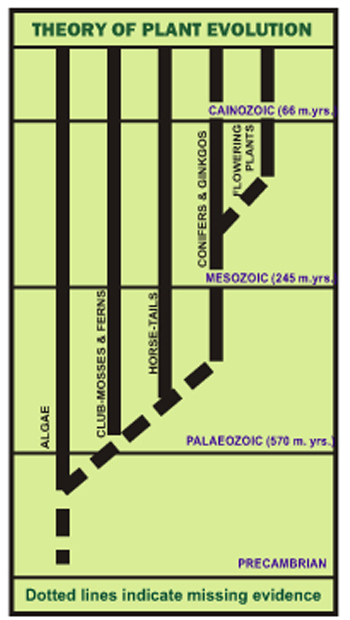PLANTS AND CREATION
THE problem evolutionists have with 'missing links' in the fossil record regarding the origin of animal life is well known. They have an even greater problem, however, with the origin of plants. One outstanding paleobotanist of modern times wrote: 'As yet we have not been able to trace the phylogenetic history of a single group of modern plants from its beginnings to the present.'1 In spite of this problem, evolutionists have a very neat theory of the origin of plants which looks very good on paper, but which has no evidence to back it up.
'AN ABOMINABLE MYSTERY'
 Evolutionists believe that the first plants lived in the sea, and that these evolved into marsh plants, then club-mosses and ferns, and conifers and ginkgos, with the flowering plants first appearing in the Cretaceous, around 141 million years ago. Each of these 'stages' appears suddenly in the fossil record with no sign of any transitions. Charles Darwin himself commented: 'Nothing is more extraordinary in the history of the vegetable kingdom, as it seems to me, than the apparently very sudden or abrupt development of the higher plants'.2 He described the origin of the flowering plants as 'an abominable mystery', and over 100 years later Harold C Bold wrote: 'In spite of advances in our knowledge... Darwin's words still eloquently summarise the current state of our knowledge.'3 The angiosperms (flowering plants) first appear as great trees, not small herbs, and they were the kind of trees which we are familiar with today: oaks, planes, willows and poplars. Botanist Edward Hyams wrote: 'To have reached that stage by 100 million years ago these plants must surely have evolved for almost as long again, and the fact that we have found no material evidence for that evolution means only that for some reason it no longer exists or that we have not looked in the right place.'(emphasis added).4
Evolutionists believe that the first plants lived in the sea, and that these evolved into marsh plants, then club-mosses and ferns, and conifers and ginkgos, with the flowering plants first appearing in the Cretaceous, around 141 million years ago. Each of these 'stages' appears suddenly in the fossil record with no sign of any transitions. Charles Darwin himself commented: 'Nothing is more extraordinary in the history of the vegetable kingdom, as it seems to me, than the apparently very sudden or abrupt development of the higher plants'.2 He described the origin of the flowering plants as 'an abominable mystery', and over 100 years later Harold C Bold wrote: 'In spite of advances in our knowledge... Darwin's words still eloquently summarise the current state of our knowledge.'3 The angiosperms (flowering plants) first appear as great trees, not small herbs, and they were the kind of trees which we are familiar with today: oaks, planes, willows and poplars. Botanist Edward Hyams wrote: 'To have reached that stage by 100 million years ago these plants must surely have evolved for almost as long again, and the fact that we have found no material evidence for that evolution means only that for some reason it no longer exists or that we have not looked in the right place.'(emphasis added).4
'EARLY' PLANTS NOT PRIMITIVE
Added to the 'missing link' problem is the fact that many of the supposedly primitive plants had complex features which, in many cases, were more advanced than the modern plants into which they are said to have evolved. Some of the plants preserved in coal (carboniferous) exhibit features superior to their modern counterparts, e.g. the horsetails, tree-ferns and club-mosses. And the elaborate bisexual flowers of '150 million year-old' cycads, were so much more advanced than those of their modern descendants, that 'devolution' seems a more apt description.

Evolutionists claim that ferns appeared long before flowering plants, but the discovery of fossil pollen grains from flowering plants in the Precambrian undermines this theory.
SINCE THE BEGINNING
However, not only is there a complete lack of evidence for the evolutionary theory of plant origin, there is actual scientific evidence that modern-type plants have been in existence since the very beginning. In 1966, Dr. Clifford Burdick reported finding the pollen grains of flowering plants in the Precambrian rocks of the Grand Canyon. His claims have been met with much skepticism, but in 1984 the Creation Research Society organised a further investigation in the Grand Canyon. Samples of the Precambrian shale — dated by evolutionists at over 570 million years old — were taken and analysed. The results completely vindicated Burdick's earlier research. Pollen grains of a number of plant types were identified including angiosperms — flowering plants which supposedly did not evolve until the Cretaceous 430 million years later! Furthermore, the presence of bright green chlorophyll led the researchers to conclude that the strata in which the samples were found 'were formed relatively recently.'5 There have been several other well-authenticated finds of pollen in the Precambrian.6
EVIDENCE FAVOURS CREATION
Was evidence of these modern-type flowering plants in the 'oldest' rocks, and no evidence of evolutionary change in the plant kingdom, we can surely agree with evolutionist Prof. E. Comer of Cambridge that 'to the unprejudiced, the fossil record of plants is in favour of special creation.'7
'God said, 'Let the land produce vegetation: seed-bearing plants and trees on the land, that bear fruit with seed in it, according to their various kinds.' And it was so.' (Genesis 1:11).
REFERENCES:
- C. A. Arnold, An Introduction to Paleobotany, McGraw-Hill 1947,p. 7.
- Charles Darwin, letter to Sir Joseph Hooker, 1881.
- Harold C Bold, Morphology of Plants, Harper & Row, 1967.
- Edward Hyams, Story of England's Flora, Kestrel Books, 1979, p. 10.
- 'Studies on Precambrian Pollen' CRS Quarterly, March 1988, pp. 173-182.
- CRS Quarterly, June 2003, pp. 15 & 23.
- E. J. H. Corner, Evolution in Contemporary Botanicals Thought, Quadrangle Books, 1961.
Factsheets published regularly by Creation Resources Trust, P.O. Box 3237, Yeovil, BA22 7WD.
(Registered charity No 1016666) www.c-r-t.co.uk © 2003

